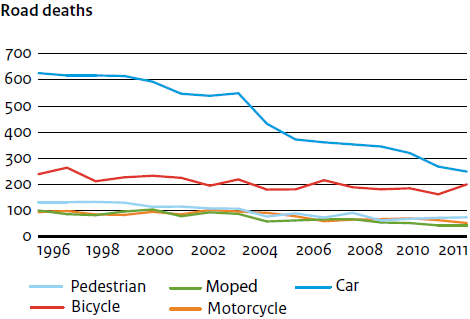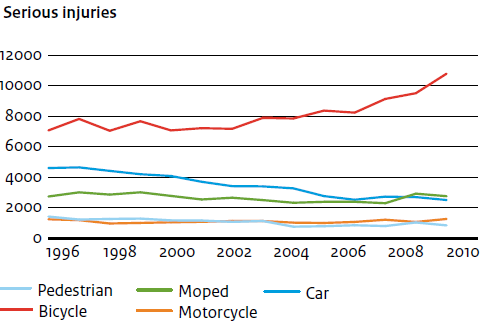
Commission road transport fatality figures shows need for safer vehicles
The Commission today released [1] the road safety figures for 2015. In 2015 26,000 were killed in road accidents in the EU compared to 25,700 the previous year. The Commission have also released a serious injury figure (based on MAIS 3+ or higher) of 135,000 serious injuries across the EU. This is the first time that there has actually been a rise in the number of fatalities on Europe’s roads. It is also the first time that the Commission has released serious injury figures.
This raises a couple of interesting issues. Firstly, the Commission said that they were going to back-track on a promise of having an EU-wide serious injury target, ECF backed an ETSC campaign to have this target re-instated [2], so this seems to be good news that there is a genuine effort on behalf of the Commission to find solutions to the lack of data that was claimed made progress difficult.
You can send a mail to your MEP to ask him/her to support a European Parliament Written Declaration asking for the re-instatement of a serious injuries target Written - Declaration for MEP to sign - A model letter text to send to MEP - A copy of the written declaration in all EU languages - You can search for your MEP here.
Secondly, it does seem that the reduction in fatalities has reached a slowdown after a huge reduction. From 1992 – to 2002 we went from 71,500 to 53,300 fatalities and then in 2012 down to 28,200. But over the past three years now we have stagnated and are seeing a plateau hovering around the 26,000 mark. In fact this year saw a rise in EU fatalities for the first time.
So what can the EU do that would have an impact on these figures?
A real EU mandate, the thing that the EU is directly involved in with regards to the three pillars of road safety (Infrastructure, behaviour, vehicles) Motor vehicles have been getting safer and safer over the years, airbags, seatbelts, crush structures, etc. but most of the interventions on the side of the vehicle has been on behalf of the occupants. The EU really now needs to start looking seriously at how to make vehicles safe for those outside the vehicle; and that means cyclists, pedestrians, motorbikes.
Although cycling fatality reduction in Europe has made progress falling around 38% between 2001 and 2010 [3], car occupant fatalities have fallen by 55% (from 27,700 to 12,345) in the same period [4]; the fall in cycling fatalities is not keeping pace with other road user modes. Even in cycle safe Netherlands there has been a stagnation in the fall of cycling fatalities, and an increase in serious injuries.


Netherlands policy document on road safety road safety ministry of infrastructure and the environment 2012
The International Transport Forum (ITF) has shown that in IRTAD countries fatalities among car occupants were reduced by 50% between 2000 and 2012, whereas decreases were only 34% for pedestrians, 31% for cyclists and 17% for motorcyclists[5].
The UK saw almost a 44% drop in car occupant fatalities per distance travelled from a 2005-2009 average to 2013, while cycling fatalities only fell 16% between those years. There was a 34% drop in car occupant serious injuries with a 31% rise in cyclist serious injuries over that same time period[6].
We have seen vehicle technologies create safer and safer spaces for vehicle occupants, but we also need to really focus vehicle safety on those outside the vehicles if the EU wishes to realise its 50% reduction of road fatalities by 2020 from 2010. Commissioner Bulc in her press conference when releasing the road safety figures that ITS and new vehicle technologies can be key to reducing fatalities and serious injuries, but we say that there needs to be a focus on using this technology for those outside the vehicle.
And coincidentally enough there is an opportunity coming up to do just this!
General Safety Regulations and Pedestrian protection update
There are going to be changes made to new vehicle type approval with a proposal to changes to the law coming out next year and a communication laying down what the Commission is thinking of changing later this year[7].
The EU leads the world in vehicle technologies with a highly developed European vehicle manufacture sector, but leads the world in vehicle safety because of progressively stronger vehicle regulations laid down in Brussels. So what can we expect to see?
Transport Research Laboratory were asked to do a cost/benefit of a list of vehicle technologies and designs that could make the grade to be fitted in all new vehicles, including[8]; Intelligent Speed Assistance – A device on the car that can either warn or physically stop the driver from going over the limit [9].
Safer lorries – this includes better direct vision designs around the cab, automatic sensing/braking facilities and underrun protection for all HGVs including construction lorries that are currently exempt. ECF worked on this to get safer lorries as part of the Weights and Dimensions Directive [10]. The Commission promised that this would be fully covered in this upcoming GSR; we look forward to working with the Commission on this.
Cyclist/pedestrian automatic detection and braking – for lorries and for cars. This is all part of the new technologies available for motor vehicles that could make real breakthroughs in road safety for those outside the vehicle.
This could be a genuinely revolutionary turning point in road safety for all road users. Vehicle technology and design has been fantastic at protecting car occupants but we forget that motorised vehicles are responsible for the vast majority of cycling/pedestrian fatalities and serious injuries as well.
Forget the hype surrounding driverless cars and autonomous vehicles, all those technologies listed above are essential for autonomous vehicles and are pretty much ready to use now. Having these technologies installed in new vehicles can be a real revolution in transport safety, particularly with regards to urban areas and those road users outside the vehicle.
If the Commission sticks to the TRL report then we will be fully behind what could be ground-breaking legislation to have these new technologies installed in new vehicles.
[1] http://europa.eu/rapid/press-release_IP-16-863_en.htm
[2] https://ecf.com/news-and-events/news/call-juncker-reverse-decision-drop-serious-road-injury-target
[3] Dakota, Traffic Safety Basic Facts 2012 Cyclists. CARE Database
[4] ETSC, Ranking EU Progress on Car Occupant Safety (PIN Flash 27), 2014
[5] ITF Road Safety annual Report 2014 Summary http://www.internationaltransportforum.org/pub/pdf/14IrtadReport.pdf
[6] UK DfT Reported Road Casualties in Great Britain: 2013 Annual Report 2013 https://www.gov.uk/government/statistics/reported-road-casualties-great-britain-annual-report-2013
[7] http://ec.europa.eu/growth/sectors/automotive/safety/index_en.htm
[8] http://bookshop.europa.eu/en/benefit-and-feasibility-of-a-range-of-new-technologies-and-unregulated-measures-in-the-field-of-vehicle-occupant-safety-and-protection-of-vulnerable-road-users-pbNB0714108/
[10] https://ecf.com/what-we-do/road-safety/safer-lorriestrucks-cyclists
Regions:
Topics:
Contact the author
Recent news!
Upcoming events
Contact Us
Avenue des Arts, 7-8
Postal address: Rue de la Charité, 22
1210 Brussels, Belgium









